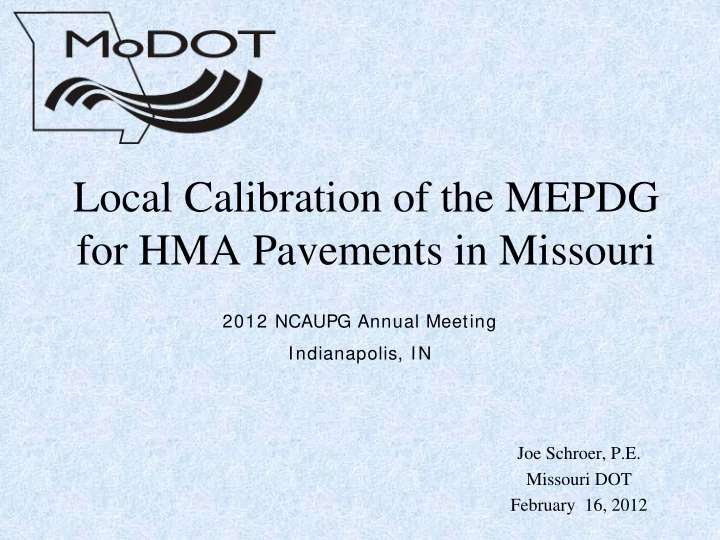

Local Calibration of the MEPDG for HMA Pavements in Missouri 2012 NCAUPG Annual Meeting Indianapolis, IN Joe Schroer, P.E. Missouri DOT February 16, 2012
MEPDG Implementation • Decision made in 2004 by MoDOT Pavement Team members, including FHWA, MAPA, and ACPA to fully incorporate the MEPDG into new pavement design activities • MoDOT contracted with ARA to calibrate the national distress models for local conditions
HMA Distresses of Interest • Fatigue cracking • Rutting • Thermal cracking
Local Calibration Data Collection • Data collection, testing, and analysis efforts split into two tasks – In-service pavement performance data for local calibration of distress models • Collected through field testing and (if necessary) project records for each identified MoDOT section • Imported from LTPP database for LTPP sections – Material testing data for MEPDG input libraries, local calibration defaults, and design guidance • Obtained through sampling and testing typical HMAs from active projects • Obtained through testing field sample cores from in- service pavements
In-Service Data Collection • 500-ft section units • 3 - 4 cores sampled from each section – Asphalt lift thicknesses – Bulk and maximum specific gravities – Air voids – Gradations – Asphalt contents • FWD testing performed on all sections • Manual cracking (2 obs./unit) & rutting (1 obs./unit) • Historical IRI
In-Service (Deep Strength) HMA Factorial HMA Thickness 4-8 inches > 8 inches Dir. Comp./ Dir. Comp./ Design Method Superpave Superpave Marshall Marshall 4” 0 0 10 Crushed Base 7 7 0 Stone Type 12 24” Rock Base 0 *MODOT Sections LTPP Sections
Age of New HMA Pavement Sections 10 MODOT & LTPP GPS-1, GPS 6A, No. of Projects LTPP SPS-8 SPS-3 & SPS-8 8 Sections Sections 6 4 2 0 5 0 5 0 5 0 5 1 1 2 2 3 3 o t o o o o o o 0 t t t t t t 5 0 5 0 5 0 1 1 2 2 3 Age, Years
Geographic Distribution of New HMA Sections Selected for Local Calibration LTPP MODOT
Illustration of a Typical Section and 500-ft Sample Units
Magnitudes of Measured Distress – MoDOT and MO LTPP HMA Pavements
Magnitudes of Measured Distress – MoDOT and MO LTPP HMA Pavements 160 100% 80% Frequency 120 Frequency 60% 80 Cumulative % 40% 40 20% 0 0% 0 21-40 61-80 101-120 141-160 181-200 IRI (in/mi)
Material Testing (Level 1) Fatigue cracking – Dynamic modulus Rutting – Dynamic modulus Thermal cracking – Creep compliance – Tensile strength
Dynamic Modulus • Testing performed with in-house AMPT • Three replicate gyratory-compacted samples of each mix type • Air voids – 4%, 6.5%, and 9% • Polymer-modified and neat (dependent on PG grade)
Dynamic Modulus • Test frequencies – 25, 10, 5, 1, 0.5, and 0.1 Hz • Test temperatures – (14)*, 40, 70, 100, and 130 ºF *estimated • Mixes completed included – SP125 PG76-22 (2) – SP190 PG76-22 – SP190 PG70-22 – SP190 PG64-22 – SP250 PG70-22 – SP250 PG64-22 – BP1 PG64-22
AMPT
Predicted (with Witczak model in MEPDG) and Measured Dynamic Modulus Master Curves for SP125 PG76-22 (SMA)
Predicted vs. Measured Dynamic Modulus for SP125 PG76-22
Master Curves @ 70F Temperature AV level=6.5 7.0 6.5 6.0 SP190 PG76-22 5.5 SP125 PG76-22 5.0 SP125 PG76-22 log(E*) (SMA) SP190 PG70-22 4.5 SP250 PG70-22 4.0 SP250 PG64-22 3.5 SP190 PG64-22 3.0 2.5 2.0 -6 -4 -2 0 2 4 6 8 10 log(tr)
Dynamic Modulus Findings • MEPDG dynamic modulus equation provides a reasonable prediction • Air void range between 4 and 9 percent has minimal affect on dynamic modulus
Creep Compliance and IDT • Testing performed under contract with Missouri University of Science and Technology (MS&T) • AASHTO T-322 • Wearing course mixes only – SP125 @ PG64-22, 70-22, and 76-22 – SMA @ PG76-22 – BP-1 @ PG64-22
Creep Compliance and IDT • Creep compliance - – Test loading times – 1, 2, 5, 10, 20, 50, and 100 s – Test temperatures– -20, -10, and 0 ºC • Indirect Tensile Strength tested at -10 ºC
IDT and Creep Compliance Equipment
Specimen Set Up
SP125 PG70-22 @ 6.5% Voids
6 Mixes @ 6.5% Voids & 0°C 0.25 0.20 Creep Compliance (1/GPa) 0.15 0.10 0.05 0.00 0 20 40 60 80 100 120 Time (sec) 125 SMA 125 100 35 Blow 100 70-22 76-22 76-22 64-22 64-22 70-22
100 Second Creep Compliance @ 6.5% Voids @ -10°C 0.090 Creep Compliance @ 100 sec. @ 6.5% voids @ -10 Deg C (1/GPa) 0.080 0.070 0.060 0.050 0.040 0.030 0.020 0.010 0.000 35 Blow 125 100 100 SMA 100 PG64-22 20% RAP PG76-22 0% RAP PG70-22 10% RAP PG70-22 10% RAP PG76-22 0% RAP PG64-22 0% RAP
IDT Strength vs % Air Voids: All Mixes: -10°C
IDT Strength: All Mixes @ 6.5% Voids @ -10°C 660 640 IDT Strength @ 6.5% voids @ -10 Deg C (psi) 620 600 580 560 540 520 100 100 35 Blow SMA 125 100 PG64-22 0% RAP PG70-22 10% RAP PG64-22 20% RAP PG76-22 0% RAP PG76-22 0% RAP PG70-22 10% RAP
100 Second Creep Compliance vs IDT Strength: -10°C
Local Calibration/Validation Steps 1. Assemble best possible input data for each sample unit a) Backcast initial IRI from historical IRI data for each section b) Backcast initial AADTT and compute growth rate from historical traffic data c) Assume MODOT specific defaults where project specific data is not available 2. Execute MEPDG runs 3. Examine predicted versus measured distress plots 4. Assess bias and error 5. Make suitable engineering and statistical analyses to calibrate models and to reduce bias and error
New HMA Pavements—Measured Versus Predicted Rutting
New HMA Pavements—Measured Versus Predicted IRI
Thank You! Questions? Prepared by John Donahue John.Donahue@modot.mo.gov
Recommend
More recommend